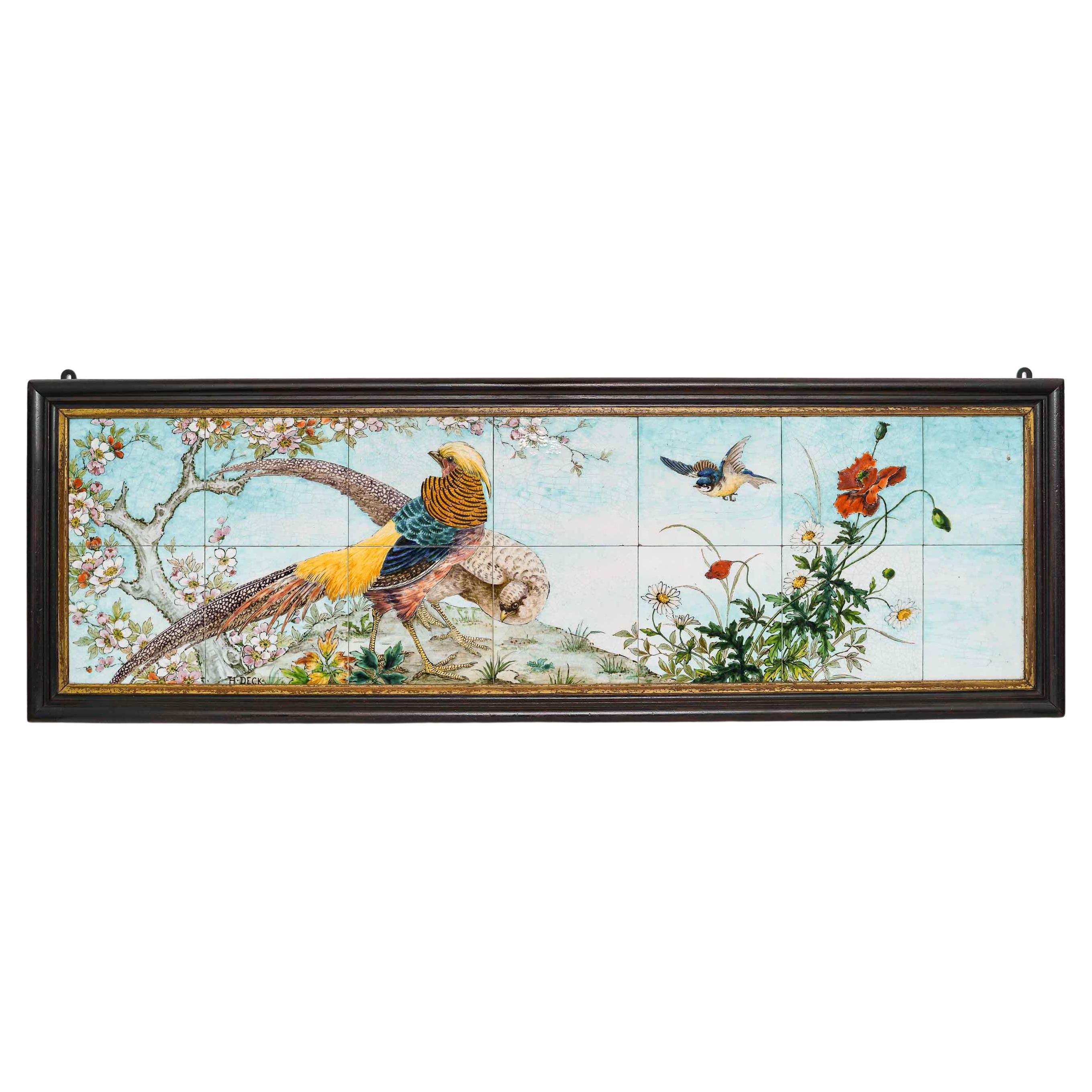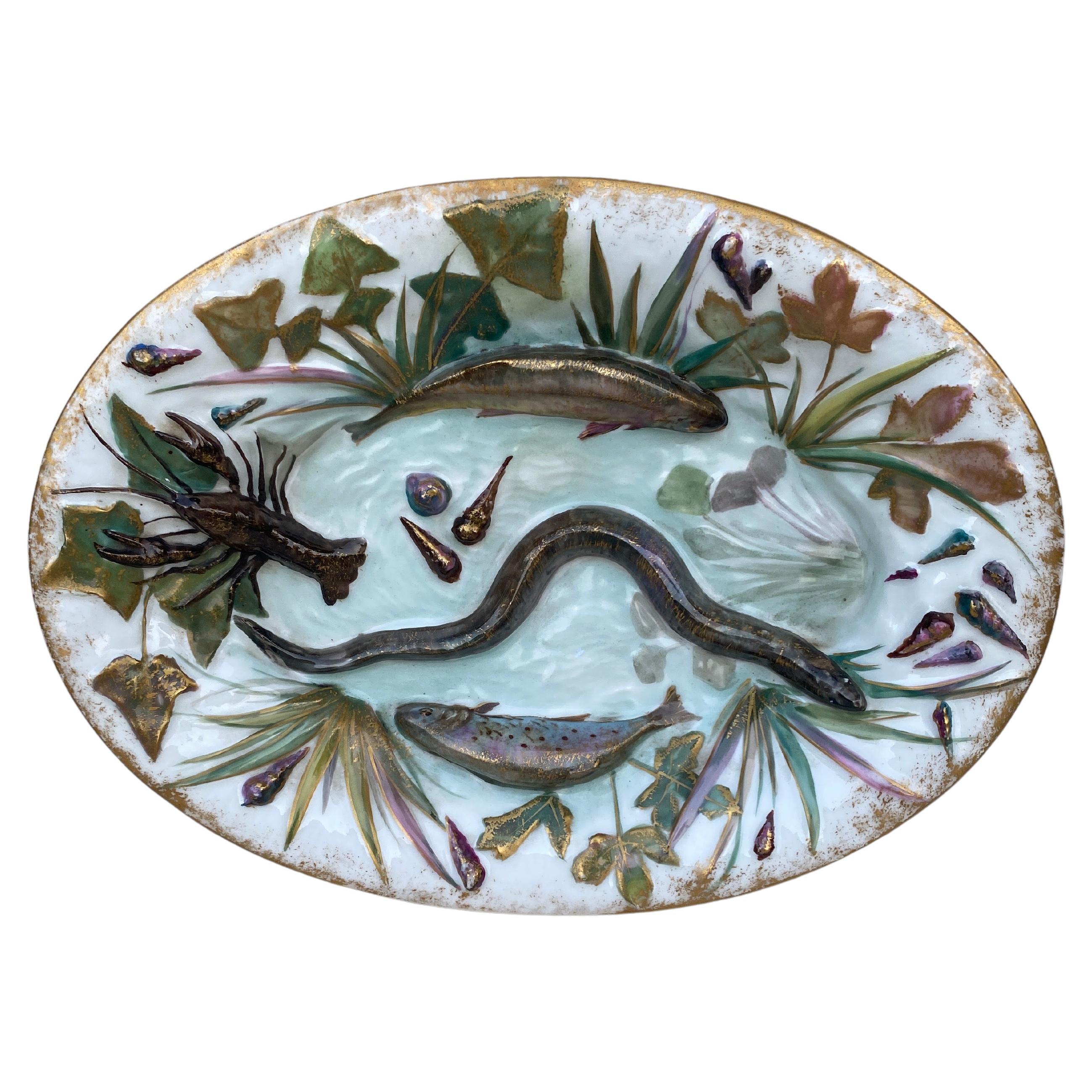Items Similar to Théodore Deck (1823-1891), an Impressive 19th Century Faïence Charger
Want more images or videos?
Request additional images or videos from the seller
1 of 11
Théodore Deck (1823-1891), an Impressive 19th Century Faïence Charger
About the Item
Théodore Deck ( 1823-1891)
Impressive polychromed circular faience charger with hand-painted enameled design of a wader among water lilies and reeds.
Impressed Uppercase Mark Th.Deck on the reverse
Circa 1875
Diameter 60.5 cm
Renowned ceramist, Théodore Deck, born in Guebwiller in 1823, apprenticed in Strasbourg in the Hügelin pottery. After an initiatory stay throughout Europe, he arrived in Paris in 1847. It was in 1861 that he made his first public appearance at the Salon des Arts et de l'Industrie in Paris, where he won a silver medal for his exhibited works. Recognized since that time, Deck is deeply influenced by the artistic trend of the moment: Orientalism. He then uses with great precision the Oriental naturalistic motifs. Emile Reiber (1826-1893), who worked at Christofle as chief draughtsman, also made sketches for Deck. His fame won by long works is imposed at the Universal Exhibitions in which he participates: in Vienna in 1873, where he leaves all his rivals behind; in Paris in 1878, where he obtains the grand prize for portraits with a gold background. The "Gazette des Beaux-Arts" (Paris, 1874, Vol. XXXV, p. 310) reported that "Mr Deck, the master of the masters, is the purest glory of French ceramics." His life is a succession of achievements whose goal is to improve the technology of earthenware. Thus, it improves the rendering of colors, among which is a nov-elty, a turquoise blue commonly called «Deck Blue». Theodore Deck is talented and knows it. However, he does not keep his art to himself, he shares it with other artists and launches young talents without fortune. It illustrates the revival of ceramic art in the second half of the 19th century. All his methods are made public and disseminated in a book on earthen-ware. His recognized genius, promoted to the rank of Officer of the Legion of Honor, he was appointed in 1887 administrator of the manufacture of Sèvres.
- Creator:Theodore Deck (Maker)
- Dimensions:Height: 2.96 in (7.5 cm)Diameter: 23.82 in (60.5 cm)
- Style:Japonisme (Of the Period)
- Materials and Techniques:
- Place of Origin:
- Period:
- Date of Manufacture:circa 1875
- Condition:Repaired: Museum restoration on crack. Wear consistent with age and use.
- Seller Location:Saint-Ouen, FR
- Reference Number:1stDibs: LU2612339567822
About the Seller
4.9
Vetted Seller
These experienced sellers undergo a comprehensive evaluation by our team of in-house experts.
1stDibs seller since 2017
57 sales on 1stDibs
Typical response time: 1 hour
- ShippingRetrieving quote...Ships From: Saint-Ouen, France
- Return PolicyA return for this item may be initiated within 2 days of delivery.
More From This SellerView All
- Théodore Deck (1823-1891) Faience Paneled Fourteen-Tile Rectangular Wall PlaquBy Theodore DeckLocated in Saint-Ouen, FRA Théodore Deck (1823-1891) Faience Paneled Fourteen-Tile Rectangular Wall Plaque Polychromic Earthenware very finely hand-painted, designed with a couple of pheasants among vegetat...Category
Antique 1870s French Japonisme Decorative Art
MaterialsFaience, Wood
- Theodore Deck '1823-1891', a Japonisme Polychromed Faience Quadrangular VaseBy Theodore DeckLocated in Saint-Ouen, FRTheodore Deck (1823-1891) A Polychromed Faience quadrangular vase, decorated in a cartouche with butterfly and birds on branches of prunus and peonies in the Japanese Taste on a pu...Category
Antique Late 19th Century French Japonisme Vases
MaterialsFaience
- Théodore Deck (1823-1891), Miniature Pair of Faience Vases circa 1870By Theodore DeckLocated in Saint-Ouen, FRTheodore Deck (1823-1891) A deep green enameled faience miniature pair of vases molded in the Chinese Archaistic Taste. Coves in the shape of elepha...Category
Antique 1870s French Chinoiserie Vases
MaterialsFaience
- French 19th Century Pair of Porcelain Cache-PotsLocated in Saint-Ouen, FRPair of polychromed hand painted porcelain with Japonisme floral decoration Ormolu-mounted with open-worked base and rim Louis XVI Style circa 1880.Category
Antique 1870s French Chinoiserie Planters, Cachepots and Jardinières
MaterialsOrmolu
- Impressive French 19th Century Neo-Greek Style Bronze Nine-Lights CenterpieceBy Georges Emile Henri ServantLocated in Saint-Ouen, FRAn impressive French 19th century Neo-Greek style bronze nine-lights center piece In patinated and gilt bronze, engraved on the body of foliage and rings, the collar decorated with a frieze of palms in bas-relief. It is held by a tripod base decorated with shards, foliage, and fins, in the center a mask of man. Surmounted by three arms, nine-lights ending in lion’s paw. Curved triangular base with ivy friezes, and palm-leaf feet. Attributed to Georges Emile Henri...Category
Antique 1860s French Napoleon III Vases
MaterialsBronze
- French 19th Century Pair of Lacquered Bamboos Japonisme VasesBy Ferdinand Barbedienne, Edouard LievreLocated in Saint-Ouen, FRA 19th French century pair of Lacquered Bamboos Japonisme vases. An amazing pair of tall cylindrical bamboo vases decorated in Japanese Gold and Sil-ver Hiramaki-E Lacquer with Pavilions in The Mist and Weaving Figures, Flown Over by a Pair of Cranes. Enclosed in a Sino-Japanese Inspiration Golden and Brown Patina Bronze Mount Featuring Elephant Heads, Partially Openwork Branches and Salamanders Forming Side Handles. Circa 1870 Attributed to Édouard Lièvre (1828-1886) and Ferdinand Barbedienne (1810-1892) Édouard Lièvre (1828-1886) is one of the most talented and prolific designer and industrialist of the 19th Century, his repertoire is sometimes Sino-Japanese or Neo-Renaissance, whether in furniture or works of art, we can note in particular the parade bed of Valtesse de La Bigne, furniture commissioned by the painter Édouard Detaille or even Sarah Bernhardt, and the famous works in collaboration with Maison Christofle or those in gilded bronze and cloisonné enamel edited by Ferdinand Barbedienne, presented at the Universal Exhibitions in 1878, 1889 and 1900. He was both a draftsman, painter, illustrator, engraver, ornamentalist and cabinetmaker, first trained in the studio of the painter Thomas Couture, Lièvre was then fully immersed in the world of decoration, creation and ornamentation and provides designs for manufacturers and merchant-publishers. Often assisted by his brother Justin, he first produced works of art for his own apartment, seeking out the finest craftsmen to execute his designs for bronzes, ceramics, fabrics and luxury furniture from great virtuosity and great taste. He then collaborated with the cabinet-maker Paul Sormani, as well as haberdasher merchants such as the Escalier de Cristal, bronziers such as Maison Marnyhac and especially Ferdinand Barbedienne as on our vases with bronze mounts characteristics of Edouard Lièvre's work. Born in 1810, died in Paris in 1892, Ferdinand Barbedienne, the most important caster of bronze pieces of art during the second half of the 19th Century, created and directed in Par-is one of the major artistic foundries of his time. Barbedienne specialized in classical reproductions, whose models were exposed in famous European museums. Their illustrated catalogues included many diverse objects such as busts, ornemental sculpture (clocks, candelabras, cups) sometimes even life-sized and bronzes for furniture. Apart from his own produc-tion, Barbedienne worked for the most renowned sculptors such as Barrias, Clésinger and Carrier-Belleuse. All his works were highly esteemed and he, himself honored by contemporary critics. At the London exhibition in 1851 Barbedienne’s firm won two « Council medals ». At the 1855 Universal Exhibition, he won a medal of honor. The success of Barbedienne’s firm brought him many official commissions, such in about 1860, as Barbedienne supplied bronzes for furniture for the Pompeian Villa of Prince Napoléon-Joseph, located avenue Montaigne in Paris. At the London Universal Exhibition of 1862 Barbedienne won medals in three different categories: Furniture, Silversmith work and Artistic bronzes. Barbedienne was made an officer of the Légion d’Honneur in 1867 and Commander in 1878 when he was compared with « a prince of industry and the king of bronze casting ». His glory did not decline with the passage of the time for at the Universal Exhibition of 1889 the critics thanked Barbedienne for the example he set for other bronze-casters by the perfection of his bronzes. “Japonisme” in the second half of the 19th century, was a craze for everything that came from Japan or imitated its style. The word was first coined in a series of articles published by Philippe Burty, from May 1872 to February 1873, in the French magazine “la Renaissance Littéraire et Artistique”. Far from the Academic sphere, artists seeking for new ways of expression, appropriated this discovery. Manet and the impressionists led the way to half a century of enthusiasm for Japanese art, and largely contributed to the esthetical revolution Europe experienced between 1860 and the beginning of the twentieth century. From 1862, The World’s Fairs provoked massive arrivals of fans, kimonos, lacquers, bronzes, silks, prints and books that launched the real era of Japonisme. With those exhibitions, the demand was boosted, the number of merchants and collectors was multiplied, and artists became passionate about this new esthetic. For them, its “primitivism” was probably its most important quality: artists were fond of the Japanese art’s capacity to be close to nature and to reconcile art and society by representing, with a lot of care, the most trivial objects. In painting, Edouard Manet, Mary Cassatt, Degas, Van Gogh, Gauguin were among those who were deeply inspired by Japanese art, affected by the lack of perspective and shadow, the flat areas of strong color, the compositional freedom in placing the subject off-center, with mostly low diagonal axes to the background. The Japanese iris, peonies, bamboos, kimonos, calligraphy, fish, butterflies and other insects, the blackbirds, cranes and wading birds, the cats, tigers, and dragons were endless sources of inspiration, appropriation, and reinterpretation for European artists. The occidental productions were combining styles and artistic conceptions instead of copying Japanese art slavishly. That is what brings to light the comparison between the artworks of Kitagawa Utamaro and Degas, of Katsushika Hokusai and Van Gogh The World’s Fairs of 1851 and 1862 in London, those of 1867, 1878, 1889 and 1900 in Paris, of 1873 in Vienna and of 1904 in Saint Louis presented a number of “Japanese-Chinese” installations with earthenware, bronzes, screens and paintings and attracted the largest amounts of visitors In Vienna, the “Japanese village...Category
Antique 1870s French Japonisme Vases
MaterialsBronze
You May Also Like
- Burmantofts Faience "Aesthetic Movement" Plaque 19th c.By Burmantofts PotteryLocated in Great Barrington, MAThis extremely large Faience pottery plaque is the epitome of the "Aesthetic Movement" style at it's best! Thick impasto enamels create a 3-dimensional effect of flowers rising out o...Category
Antique 19th Century English Decorative Art
- Large Delft Blue and White Charger, Late 17th CenturyLocated in New York, NYPossible signature of Jan Jansz van der Laen.Category
Antique Late 17th Century Danish Decorative Art
MaterialsCeramic
- 19th Century Majolica Palissy Wicker Boat with a FishBy Thomas Victor SergentLocated in Austin, TXSmall 19th century Majolica Palissy wicker boat with a fish, very fine quality, the boat is decorated with leaves and moss.Category
Antique 1880s French Victorian Decorative Art
MaterialsCeramic, Majolica
- 19th Century Majolica Porcelain Palissy Fish Wall PlatterLocated in Austin, TXRare 19th century porcelain Palissy platter with fishs, eel, shells , crawfish and ivy leaves.Category
Antique 1880s French Victorian Decorative Art
MaterialsPorcelain, Ceramic, Majolica
- Small 19th Century Majolica Palissy Fish Wall PlatterBy Thomas Victor SergentLocated in Austin, TXFrench small Palissy platter with a fish,plants,shells,bugs,snake,butterfly attributed to Thomas Sergent.Category
Antique 1880s French Rustic Decorative Art
MaterialsCeramic, Majolica
- Small 19th Century Majolica Palissy Fish Wall PlatterBy Thomas Victor SergentLocated in Austin, TXRare small Palissy platter with a fish, lizard, butterfly, ivy leaves attributed to Thomas Sergent.Category
Antique 1880s French Victorian Decorative Art
MaterialsCeramic, Majolica
Recently Viewed
View AllMore Ways To Browse
Gold An Silver
Silver Medals
Antique Silver Medals
19th Reverse Glass
Art Glass Charger
Gold Chargers
Enamel Charger
Antique Strasbourg
French Faience Pottery Antique
Christofle Hand
Vienna Silver Enamel
Paris Ware
Polychrome Charger
Antique Pottery Charger
Faience Charger
French Charger
Oriental Pottery
Sevres Turquoise





